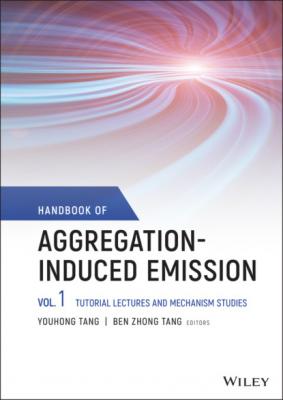Handbook of Aggregation-Induced Emission, Volume 1. Группа авторов
Читать онлайн.| Название | Handbook of Aggregation-Induced Emission, Volume 1 |
|---|---|
| Автор произведения | Группа авторов |
| Жанр | Химия |
| Серия | |
| Издательство | Химия |
| Год выпуска | 0 |
| isbn | 9781119642893 |
| Unit: eV | Absorption | Emission | Stokes shift | Reorganization energy | ||||||
|---|---|---|---|---|---|---|---|---|---|---|
|
|
|
|
|
|
|
κ sol | κ agg |
|
|
|
| DSA [57] | 2.82 | 2.75 | 0.07 | 2.18 | 2.01 | 0.17 | 0.74 | 0.64 | 0.74 | 0.64 |
| DCDPP [57] | 3.36 | 3.24 | 0.12 | 2.53 | 2.19 | 0.34 | 1.05 | 0.83 | 1.05 | 0.83 |
| TPBD [57] | 3.72 | 3.55 | 0.17 | 2.98 | 2.51 | 0.47 | 1.04 | 0.74 | 1.03 | 0.73 |
Table 2.5 Calculated kr, kic, and ΦF in both solution and aggregate phases at room temperature for HPDMCb and DCPP, respectively.
| k r (s−1) | k ic (s−1) | Φ F (%) | k r (s−1) | k ic (s−1) | Φ F (%) | |
|---|---|---|---|---|---|---|
| In isolated state | In solid phase | |||||
| HPDMCb [61] | 8.64 × 107 | 1.31 × 1011 | 0.07 | 7.95 × 107 | 2.29 × 107 | 78.0 |
| DCPP [61] | 7.98 × 106 | 1.01 × 106 | 88.8 | 3.30 × 106 | 0.61 × 106 | 84.4 |
2.4.3 Isotope Effect vs DRE
Isotope effect (IE) has been widely applied to probe the excited‐state decay process [62, 63]. For conventional luminogens, deuteration always causes the remarkable decrease of kic while almost has no effect on kr, leading to greatly increased ΦF. It is easy to understand because under the displaced harmonic oscillator model based on FGR, kic is proportional to
Figure 2.6 (a) Calculated λj versus ωj in both solution and solid phases for HPDMCb. (b) Calculated resonance Raman spectroscopy in both solution and solid phases for HPDMCb.
Source: Reproduced
